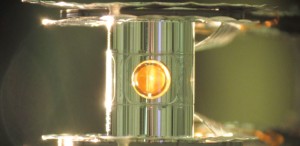Sunday Times 2
Scientists achieve ‘turning point’ in fusion energy quest
View(s):WASHINGTON (Reuters) – U.S. scientists announced on Wednesday an important milestone in the costly, decades-old quest to develop fusion energy, which, if harnessed successfully, promises a nearly inexhaustible energy source for future generations.
For the first time, experiments have produced more energy from fusion reactions than the amount of energy put into the fusion fuel, scientists at the federally funded Lawrence Livermore National Laboratory in California said.

The fuel was coated on the inside of the capsule in a frozen layer less than the width of a human hair (Reuters)
The researchers, led by physicist Omar Hurricane, described the achievement as important but said much more work is needed before fusion can become a viable energy source. They noted that did not produce self-heating nuclear fusion, known as ignition, that would be needed for any fusion power plant.
Researchers have faced daunting scientific and engineering challenges in trying to develop nuclear fusion – the process that powers stars including our sun – for use by humankind.
“Really for the first time anywhere, we’ve gotten more energy out of this fuel than was put into the fuel. And that’s quite unique. And that’s kind of a major turning point, in a lot of our minds,” Hurricane told reporters.
“I think a lot of people are jazzed.”
Unlike fossil fuels or the fission process in nuclear power plants, fusion offers the prospect of abundant energy without pollution, radioactive waste or greenhouse gases.
Unlike the current nuclear fission energy that is derived from splitting atoms, fusion energy is produced by fusing atoms together.
Experts believe it still will be many years or decades before fusion can become a practical energy source.
“I wish I could put a date on it,” said Hurricane. “But it really is (just) research. And, you know, although we’re doing pretty good, we’d be lying to you if we told you a date.”
Of the uncertain path ahead in fusion research, Hurricane compared it to “climbing half way up a mountain, but the top of the mountain is hidden in clouds. You can’t see it. You don’t have a map”.
The research was conducted at the laboratory’s National Ignition Facility (NIF), which was completed in 2009.
Zap a tiny target
The scientists used 192 laser beams to zap a tiny target containing a capsule less than a tenth of an inch (about 2 mm) in diameter filled with fusion fuel, consisting of a plasma of deuterium and tritium, which are two isotopes, or forms, of hydrogen.


